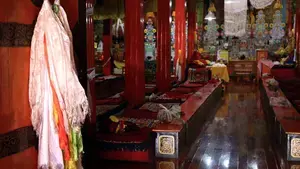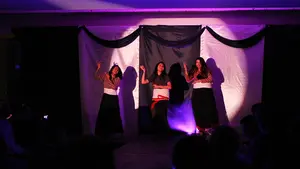Asian Studies

Areas of Study
- A dynamic interdisciplinary approach that combines the humanities, social sciences, arts and culture and language study.
- Access to a robust cocurricular program of campus speakers, visiting artists, panel discussions, symposia and exhibitions in the Cantor Art Gallery.
- Active engagement with the arts on campus, including opportunities to assist with gallery exhibitions, and participate in music, dance and theatre performances.
- Study abroad options in China, Sri Lanka, Indonesia, Vietnam and Japan and opportunities to travel to Asia for short courses in May and the summer months.
- The opportunity to study four years of Chinese language.
Major Requirements & Guidelines
Students who plan to elect an Asian Studies major must meet with the Asian Studies director, May Sim, who may be contacted directly (Smith Hall 522, msim@holycross.edu) or through Abi Blouin, academic administrative assistant (Stein 435, ablouin@holycross.edu) to construct an initial plan of study.
The course requirements for Asian Studies majors are as follows:
- One survey of Asia (PHIL 255 Asian Philosophy; PHIL 320 Self-Realization & Transcendence; RELS 106 Buddhism; or ANTH 170 Contemporary Asia). If these courses are not available to fit the schedules of students, the director can approve a substitute course that offers a broad perspective on Asia.
- One course on the Arts of Asia: This could include offerings in literature, theatre, studio art, art history and music with a limit of three courses in the performing arts.
- One course that offers a historical perspective: This course should be taken with a faculty member in the history department who specializes in the area that a student chooses to investigate, e.g., in East, Southeast or South Asia.
- One course that focuses on religion in one or more areas of Asia. Normally these courses would be taken from faculty in the religious studies department or in another department with the approval of the director.
- One course that provides a methodological or analytical framework for approaching the study of Asia. This course does not need to focus on an Asian theme. In consultation with their Asian Studies advisor, students may choose this course from approved offerings in academic departments.
- At least three additional courses on Asia with two of them above the 100 level.
The requirement for a major is knowledge of an Asian language equivalent to one year of college study in a language relevant to the geographic area or theme on which the student chooses to focus. This requirement can be fulfilled in a number of ways:
- Completion of one year of language study at the College.
- Completion of intensive language study as part of an approved study abroad program or an approved summer program.
- Students who acquire knowledge of an Asian language in alternative ways, e.g., through advanced placement or non-credit bearing language study such as online courses or who are heritage speakers must be evaluated by a language placement exam. These students must take additional electives to fulfill the 10 course minimum requirement for the major. Students can email Prof. Ji Hao (jhao@holycross.edu) regarding this process.
Minor Requirements & Guidelines
Students may elect a minor in Asian Studies in conjunction with any major. Students are normally expected to declare the minor by the second semester of their third year.
Students who plan to elect an Asian Studies minor must meet with the Asian Studies director, May Sim, who may be contacted directly (Smith Hall 522, msim@holycross.edu) or through Abi Blouin, academic administrative assistant (Stein 435, ablouin@holycross.edu) to construct an initial plan of study.
In order to fulfill requirements for the minor in Asian Studies, students must complete six courses according to the following requirements:
- One survey course from a list of regular offerings that provide a broad overview of Asia (PHIL 255 Asian Philosophy; PHIL 320 Self-Realization & Transcendence; RELS 106 Buddhism; or ANTH 170 Contemporary Asia). Students who cannot enroll in one of these introductory survey courses can work with the director of the program to find a suitable alternative course.
- In addition to the survey course, students must choose five electives on Asia.
- We strongly encourage students to elect at least one course in each of two subregions of Asia: South and Southeast Asia (India, Sri Lanka, Nepal, Vietnam or Indonesia) and East Asia (China, Japan and Korea).
- Two courses taken in a College-approved Study Abroad Program may count toward the minor. Students should consult with the Asian Studies director to make sure that courses taken abroad fulfill the proper requirements.
- Asian American Studies
- Elementary Chinese 1
- Introduction to Chinese Culture
- Discovering Hong Kong
- Chinese Migrants and Language Acquisition
- Gender in the Sinophone Sphere
- Alexander the Great and Asia
- Modern India
- Modern Japan
- Asian Revolutions
- East Asia Displayed: Global Sports and International Exhibitions
- Music Of Bali-Gamelan 1
- Emotion and Reason: East & West
- Confucian Values & Human Rights
- South Asian Politics
- Buddhism
- Ancient and Medieval Hinduism
- Readings: Asian Sacred Texts
- Gardens & World Religions
- Asia on Stage
- Balinese Dance 1 - 2
Meet Your Program Director

Opportunities
Asian Studies Award
The Karen Gottschang Turner Asian Studies Award is presented to a fourth-year Asian Studies major or minor who has submitted the most outstanding piece of scholarly or artistic work as judged by a committee of Asian Studies faculty. The award also recognizes distinctive academic achievement in the Asian Studies curriculum and contribution to the Asian Studies Program.
Balinese Arts Program
The gamelan gong orchestras of Indonesia’s Bali and Java are world famous, as are Indonesian masked theatre traditions, textile arts, and village dance rituals. Holy Cross is one of the few liberal arts colleges to offer a full range of courses in Balinese gamelan music and dance with our own gamelan ensemble, performance opportunities and Indonesian instructors.
Cocurricular Programming
Asian Studies sponsors a robust cocurricular program of intellectual, cultural and social events, including lectures by internationally renowned scholars, panel discussions on current events, Cantor Art Gallery exhibitions curated by faculty or organized by museums, music and dance performances (including Balinese Gamelan), workshops introducing Buddhist meditation and an annual Chinese Lunar New Year celebration.
Research
Asian Studies students actively engage in research and artistic production on and off campus.
Students in recent years have received grants to conduct research in Indonesia, Vietnam, Malaysia and the United States. They have co-curated or assisted with gallery exhibitions on Southeast Asian textiles, analyzed the social and cultural dynamics of border trade between Cambodia and Vietnam, conducted research with Asian refugee communities in Worcester, worked as summer program resident assistants in Chinese, and have performed in music, dance, and theatre productions on campus and at festivals in Asia.
Study Abroad & Away
Intensive Chinese Language Programs are offered in Taiwan, Beijing and Shanghai.
Student Organizations
Several student programs and opportunities exist to further your learning in this area:
Holy Cross Anime Club
KPop Dance Crew
Pinoys of Worcester
Advocating Student Interest in Asia (ASIA)
Developing and Educating South-Asian Ideologies (DESI)
Multicultural Peer Educators (MPE)
Developing and Educating South-Asian Ideologies (DESI) fashion show
Outcomes

Students go on to a wide range of careers with international scope, including international affairs, public policy, law, business, journalism, scholarship, technology and the arts. Read our Student Stories for news on a few recent graduates. Many students have also gone on to earn prestigious fellowships such as the Fulbright award to teach, conduct research and work in Asia.






